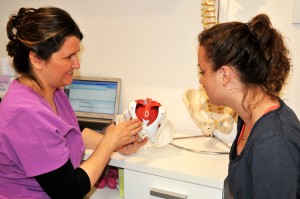We use cookies to improve your experience.
Learn more.
By Judith Landhausser HCPC, MCSP, MACPWH, PG Dip (Women’s Health)

Patients ask me quite often how I could choose a job like this! And yes, I would probably ask the same question. But as life goes, sometimes you do the unexpected and I never thought that looking at women’s pelvic floors could actually turn into a really uplifting job.
Women that come to see me usually have one of those issues that you might have seen on TV under “embarrassing problems” and often related to their pelvic floor.
When your pelvic floor has stopped doing its job well, than it can cause stress incontinence. This is when one leaks urine when the bladder experiences stress e.g. when coughing, sneezing, laughing, sometimes lifting or even just when moving abruptly.
It also can contribute to “your bits falling out” or in more medical terms your bladder, bowel and/or uterus moving downwards into the vagina, which is then called prolapse.
So two really important jobs that this pelvic floor does: it keeps you continent and stops everything from falling out.
You might think, as we all do, that this is not something that could ever become a problem for you. Unfortunately there are some factors that contribute massively to this and the biggest is child birth! This should not really be a problem, as someone who has broken their leg will usually be able to walk and run again after some convalescence time and rehabilitation of their leg muscles.
But do we really rehabilitate our pelvic floor muscles after child birth? Even I did not think about my pelvic floor then, as I really struggled with being a new mum, having so much new things to focus on, being overwhelmed with the love and dedication for my child that my needs did not count. I was very convinced that MY pelvic floor muscles will be okay and will recover by itself : )
This is our downfall and this is why I am writing this article.
Please girls, do not ignore your pelvic floor muscles! Ever! Especially not if you are a mum; no matter if caesarean or natural delivery, any assisted delivery really needs to work extra hard, as that can be quite traumatic on the pelvic floor. Being pregnant already is stress on the pelvic floor, as the extra weight and the baby press down on the pelvic floor. If you have a toddler whilst you are pregnant, it is extra stressful for your muscles, as you carry the toddler on top of all this extra weight!
Now the question is: how do I do pelvic floor exercises? The unlucky situation is that only 60% of us know how to do an effective pelvic floor contraction. If you are unsure if you do it right, you can see if you can stop your urine flow midstream. This is not an exercise! Only a one of test!!
If it stops than you can say that you can activate your pelvic floor.
If it doesn’t stop than it might not be a wrong contraction but definitely not a strong enough contraction to stop the flow.
If the flow gets stronger when you are trying to stop it, then you are actually straining the pelvic floor, which is the wrong movement.
Once you are reassured that you are contracting your pelvic floor, you should aim to do 10 pelvic floor contractions in a row. Aim to hold them 10 seconds and have a 4 second break in-between. Follow those with 10 short (1second) but strong pelvic floor squeezes, make sure you relax your muscle after every contraction.
Ideally you manage that sequence 2-3 times a day.
If you breastfeed or bottle feed, than that might be a good time, if you spend time in the play ground waiting for your child to come out of nursery, school or other activities that might be a good time as well, commuters can definitely do it on the train 🙂
I always do mine at night, when I am taking my son to bed, which helps me staying awake, while I wait for him going to sleep.
People should not be aware that you are contracting your pelvic floor! If they are than you are either doing the wrong thing or are using your big muscle groups to help. If you struggle to keep your facial expressions relax, than pretend you are checking your phone or so.
Another very important point is that whenever you feel a sneeze or a cough coming or when you lift something, contract your pelvic floor muscles beforehand and try and hold them tight during the activity. This will
a) strengthen your pelvic floor during your daily activities
b) help with leaking problems if there are any
c) support your pelvic organs, when pressure is coming down onto them.
You are teaching your kids to cover their mouth when they cough and sneeze and eventually they do that without being bugged about it. So I want you to implement this technique until it just happens without you needing to think about it.
If you should have a problem with stress incontinence or a prolapse than I really would recommend you to do these exercises religiously.
If you are not sure if you are doing them right, then seek help in finding out. The POGP (Pelvic, Obstetric and Gynae Physiotherapists) has got a list of us, physiotherapists qualified to deal with continence and women’s health issues.
Often it takes one visit to get reassured and to have someone checking that your pelvic floor does what it is meant to do, sometimes it takes a couple of visits, with the second time checking that you are making progress. Some women need more input, but more often it is quite straight forward. You obviously can always go and consult your GP or Obstetrician/Gynaecologist as well.
Now why do I find my job uplifting? I can create an environment where women that have issues with their bladder (incontinence, urgency, frequency), vagina (pain during intercourse, prolapse) or bowel (incontinence) can talk freely about their despair, about the problems that they are facing that they would like to tackle. Not all those problems can be solved with physiotherapy only, but we can achieve quite a lot for most of our patients. It is a pleasure to see women leaving after the treatment understanding why they have certain problems, that they can do something about it and what they can do about it. It makes them feel empowered and more confident and I tell you something that is the nicest thing in my job. Giving women the ability to make a difference in their life’s again.
If you have questions you can e-mail me on or you can see me here for an appointment.
Wishing you all the very best with your pelvic floor exercise programme, Judith x

written by
Registered and Chartered Physiotherapist
HCPC MCSP POGP PG Dip (Women’s Health)
Clear Passage Practitioner
FSM Practitioner & Instructor
